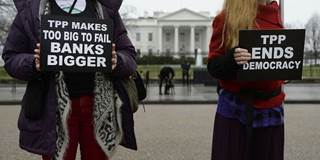Economists are all but unanimous in arguing that the macroeconomic effects of US presidential candidate Donald Trump’s trade proposals would be disastrous. But just because economists agree doesn’t mean they’re right.
PORTO – One thing is now certain about the upcoming presidential election in the United States: the next president will not be a committed free trader. The presumptive Democratic nominee, Hillary Clinton, is at best a lukewarm supporter of freer trade, and of the Trans-Pacific Partnership in particular. Her Republican counterpart, Donald Trump, is downright hostile to trade deals that would throw open US markets. Breaking with modern Republican tradition, Trump envisages a 35% tariff on imported cars and parts produced by Ford plants in Mexico and a 45% tariff on imports from China.
Economists are all but unanimous in arguing that the macroeconomic effects of Trump’s plan would be disastrous. Repudiation of free and open trade would devastate confidence and depress investment. Other countries would retaliate by imposing tariffs of their own, flattening US exports. The consequences would resemble those of the Smoot-Hawley Tariff, enacted by the US Congress in 1930 and signed by an earlier, disgraced Republican president, Herbert Hoover – a measure that exacerbated the Great Depression.
But just because economists agree doesn’t mean they’re right. When the economy is in a liquidity trap – when demand is deficient, prices are stagnant or falling, and interest rates approach zero – normal macroeconomic logic goes out the window. That conclusion applies to the macroeconomic effects of tariff protection in general, and to the Smoot-Hawley Tariff in particular. This is a point I demonstrated in an academic paper written – I hesitate to admit – fully 30 years ago.

PORTO – One thing is now certain about the upcoming presidential election in the United States: the next president will not be a committed free trader. The presumptive Democratic nominee, Hillary Clinton, is at best a lukewarm supporter of freer trade, and of the Trans-Pacific Partnership in particular. Her Republican counterpart, Donald Trump, is downright hostile to trade deals that would throw open US markets. Breaking with modern Republican tradition, Trump envisages a 35% tariff on imported cars and parts produced by Ford plants in Mexico and a 45% tariff on imports from China.
Economists are all but unanimous in arguing that the macroeconomic effects of Trump’s plan would be disastrous. Repudiation of free and open trade would devastate confidence and depress investment. Other countries would retaliate by imposing tariffs of their own, flattening US exports. The consequences would resemble those of the Smoot-Hawley Tariff, enacted by the US Congress in 1930 and signed by an earlier, disgraced Republican president, Herbert Hoover – a measure that exacerbated the Great Depression.
But just because economists agree doesn’t mean they’re right. When the economy is in a liquidity trap – when demand is deficient, prices are stagnant or falling, and interest rates approach zero – normal macroeconomic logic goes out the window. That conclusion applies to the macroeconomic effects of tariff protection in general, and to the Smoot-Hawley Tariff in particular. This is a point I demonstrated in an academic paper written – I hesitate to admit – fully 30 years ago.